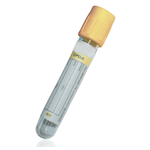Suitable Specimen Types
- Serum
- EDTA Plasma
- Li Hep Plasma
Turnaround Time
14 daysSample Stability
Stable at between 2C and 8C up to 14 daysMyositis Antibodies
General Information
The EUROLINE Autoimmune Inflammatory Myopathies 16 Ag (IgG) measures IgG autoantibodies to 15 different antigens: MI-2α, Mi-2β, Ku, PM-Scl75, Jo-1, SRP, PL-7, PL-12, EJ, OJ, Ro-52,TIF-1γ, MDA5, NXP2 and SAE1 in serum or plasma. It is primarily used for the diagnosis of dermato- and polymyositis, idiopathic myositis, anti-synthetase syndrome and overlapping syndrome.
Myositis is an inflammatory disease of skeletal muscles, which may be hereditary or can be triggered by infections, toxins or immune system disorders. Autoimmune myostides occur with an incidence of 0.1 to 1/100,000/year, a prevalence of 1 to 6/100,000 and a male: female ratio of 1:2.
Notes
|
Autoantibody |
Clinical Relevance |
|
Mi-2a,Mi2b |
Autoantibodies against Mi-2 (including isoforms Mi-2α and Mi-2β) have a high specificity of around 95% for myositides, in particular dermatomyositis with hypertrophia of the nail folds. They can be found in 15-30% of patients with dermatomyositis, but can also be detected in 8-12% of patients with idiopathic myositis. Anti-Mi-2 antibodies can usually be detected in the early stage of disease |
|
Ku |
Originally described in polymyositis-scleroderma overlap syndrome. Approximately 40% of patients with antibodies against Ku show symptoms of myositis or SSc. They also occur with a prevalence of up to 10% in SLE and can occur in Sjogrens syndrome |
|
PM-Scl100/PM-Scl75 |
Anti-PM-Scl antibodies are detected in 50-70% of patients with so-called overlap syndrome. Antibodies against PM-Scl75 can be detected in ~3% of polymyositis cases, in ~2-3% of patients with SSc and in 24-50% of patients with overlap syndrome |
|
Jo-1 |
Found in polymyositis with a prevalence of 25-55% and a specificity of almost 100%. They are often associated with simultaneously occurring autoimmune diseases such as SLE, SSc or interstitial lung fibrosis |
|
SRP |
Can be detected in around 5% of cases of polymyositis (at a specificity of ~90%). Anti-SRP antibodies are a marker for necrotising myopathy (anti-SRP syndrome). |
|
PL-7 |
Occur with a prevalence of around 3% to up to 6% in patients with myositis. In some cases can overlap with SLE, SSc or interstitial lung disease. |
|
PL-12 |
Detected with a prevalence of ~3% in myositis patients |
|
EJ |
Diagnostic marker for polymyositis with a prevalence of 1-3%. |
|
OJ |
Associated with polymyositis (prevalence 3%) and interstitial lung fibrosis (prevalence 3%). |
|
Ro-52 |
Detected in myositis patients with a prevalence of 25%. Also occurs in some rheumatic and non-rheumatic diseases. Associated with neonatal lupus and congenital heart block |
|
TIF1 g |
TIF1g autoantibodies are detected in approximately 15% and exclusively in patients with dermatomyositis. In approx 58% of patients who test positive for anti TIF1g DM is associated with a malignant disease. |
|
MDA5 |
MDA5 autoantibodies are detected in 13 – 26% of patients with dermatomyositis |
|
NXP2 |
NXP2 autoantibodies are detected in 18-25% of cases of juvenile Polymyositis/dermatomyositis and in only 1% of adult cases. This form of PM/DM is characterised by accompanying Calcinosis and particularly severe and chronic disease courses. |
|
SAE1 |
Anti SAE1 auto antibodies are markers with a high specificity for DM and occur in 8% of patients. In adult patients with DM associated with interstitial lung diseases they are found in 5% of cases |
Reference Range
Interperative assay , results reported as positive, negative or equivocal.
Source of Reference Range
Provided by Euroimmune ( kit manufacturer, references detailed in kit insert)Specifications
- EQA Scheme?: Yes
- EQA Status: Myositis associated Antibodies (PILOT scheme)
